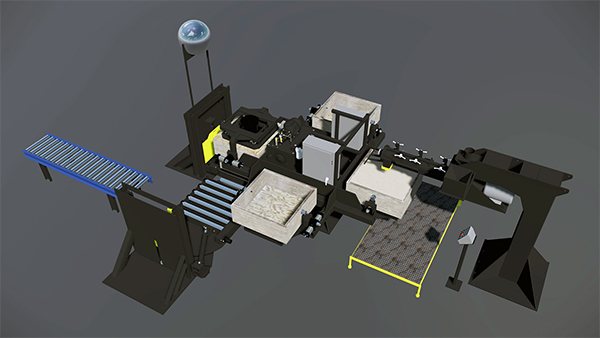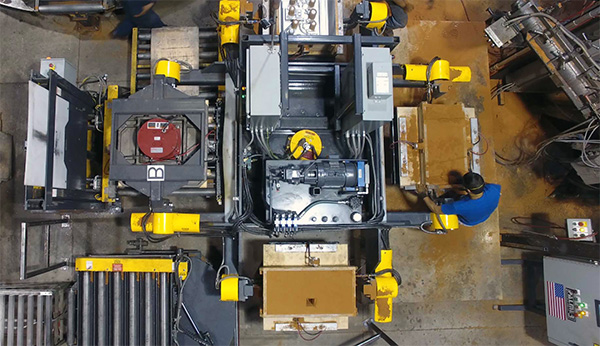Foundry & industrial processing Machinery EQUIPMENT & SYSTEMS
U.S. & Canada Call 1.800.457.5456
Lowering Labor Costs for No-Bake Molding
Home Articles Lowering Labor Costs for No-Bake Molding

Foundry Management & Technology Magazine, January, 2020 issue.
Written - Jack Palmer.
Reprinted by permission of Penton Media, Inc.
Sand molding systems can be enhanced with automation and other technologies, to perform reliably without an operator.
Considering the extremely tight labor availability today, any process or system that can reduce labor costs should be explored. All of the molding systems presented here have enhancements designed to reduce labor. Additionally, these systems can be equipped with Smart technologies (including RFID “teach play”) so that once a job is filled, compacted, and struck-off manually, it will perform these functions automatically without an operator when the tool comes back to refill, or is initially put into production for the day.
Automatic strike-off machines also are available and easily added to most systems. Rollover draw machines, the workhorse of any molding system, can be configured for 100% automatic function.
Staffing for all molding systems is roughly the same (depending upon size), but typically there will be one mixer operator, one utility operator to help strike-off and set sleeves and rods, and a third operator to help with pattern changes and bringing consumables to the mold and prep areas. Obviously, there will be more labor needed for coating, coring, closing, and clamping functions, but those are outside the scope of this discussion.
The following popular molding systems can be categorized as those systems with and without a rollover.
Square-loop molding system - The most popular system for producing chemically bonded sand molds worldwide are variants of what is commonly called a "square loop" or "fast loop.""
Operation: Operator fills, compacts, and strikes off on a compaction table. Once the mold is struck off it is moved using varying designs of power roller conveyor, power belts, powers transfer cars, and a rollover that separates the sand mold from the tooling. The mold exits the rollover and is followed by the tooling. The mold moves away from the loop for the subsequent loose piece removal, coating, and drying (if ferrous), placing the cores or core packages in the drag, closing the cope over the drag, and clamping. Then, the mold is ready to be poured. Tooling is either returned to the loop or removed and replaced with the next job.
Advantages: Regarding material handling, this type of loop has been proven hundreds of times around the world. It can easily be custom configured to the available floor space, to the types of work being made, and any special needs like chill setting, ram-up cores, or reinforcing rods. Changes to this design are fairly straightforward – if the type of work changes, or the rate of production needs to increase, different machine types can be added or removed.
Disadvantages: Compared to other designs, more floor space is required and the complete system is comparatively expensive. Maintenance costs will be high because there will be dozens of proximity switches, motors, gearboxes, chains, and sprockets. Rollovers are inherently complex, with hydraulic valves and cylinders, motors, switches, and beam devices (for proof of position, proof of draw), pneumatic valves, power cords, and hydraulic hoses and lines. Wheels and track on the transfer cars will require maintenance, as will the festooning that brings power to the transfer cars, on-board power roller conveyor, and the drive to move the car on the track. The control system, while not overly complex, is often custom-designed, adding to the cost and complexity.

In general, the maximum production rate maxes out at 15 molds per hour because the cycle time of the rollover (box-in to box-in) is usually about two minutes.
Carousel rollover molding system - This is the second most popular molding design. Generally, a carousel will have three to four jobs on board with six or eight boxes.
Operation: An empty box is pulled off the carousel onto the compaction table; filled, compacted and struck off; and returned to the carousel, which is then indexed one station. The fill station is positioned at 180° from the rollover station, so that a full box moves into the rollover, the mold is drawn, and it moves outboard of the rollover. An empty box is returned to the carousel.
Advantages: The main one is the simplicity and low cost compared to the square loop. The complete system has a single drive mechanism to index, which eliminates the dozens of gearboxes, chains, sprockets, proximity switches, etc. Programming is simplified too, as the carousel is the lone moving part in the system.
Capital costs are much lower, for obvious reasons. A proper design has gravity rollers on board to eliminate the complexity of powering a conveyor on a rotating mechanism. A simple pusher moves the full box into the rollover and the power roller conveyor on the rollover pushes the empty box back onto the carousel.
Disadvantages: The perceived disadvantages are the fixed number of stations / time to change patterns, or perform the necessary prep functions with rods, sleeves, etc. With proper system design, pattern changes can be accomplished easily “in cycle,” meaning the normal amount of time it takes to fill, compact, and strike-off a box, which, in general, is two minutes.
Since the mount board on every job is the same, there is no need for accurate positioning of the box on the station, regardless of size, which makes the pattern change simple and efficient.

Unless changing tooling, there are three stations to perform any necessary prep work, allowing for six minutes to blow out the box and place insulating sleeves, any reinforcing rods and ram-up cores, and chills. If proper material handling methods are followed, all prep materials will be ready and correct for every job as soon as the carousel stops moving. In the case of a high number of chills (as in complex aerospace castings, it might require more than six minutes. But, if a "kit" is prepared in advance for each job, even dozens of chills can be placed in cycle.
The rollover will have the same capital costs and maintenance requirements as the conveyor-based system, and the production rate also will be a maximum of 15 molds per hour. Space requirements are generally less than the conveyor based system.
Flip molding machine system - The FMM is a comparatively recent development in chemically bonded mold production systems, in general with four or six stations. A station is a cast iron, Blanchard-ground platen that inverts using a hydraulic actuator.
Operation: The box is fastened to the platen and filled. A vertical vibrator mounted on the bottom of the platen compacts the mold before striking off in place. The system is indexed for one station; the station between filling and drawing is for set-up time.
When the box is at the draw station, the whole platen inverts. A precision draw platform elevates to the mold surface, the retaining pins which hold the mold to the box when inverting are drawn, and the same vibrator used for compaction starts and the draw platform lowers. The draw station is equipped with proof of draw identical to a normal rollover.
When the mold is on the lowered draw table it is quickly moved away while the machine is indexing one station and the platen is inverting back to the fill configuration. The station before filling is the prep station.
Advantages: Capital costs are comparable to the carousel/rollover design, which is much less than the conveyor-based system.
Maintenance costs are extremely low as there is no rollover. Each station, along with the draw table, is its own rollover; the platen is inverted with heavy-duty hydraulic actuators mounted to the platen so that the center of gravity is level with or above the actuator, making the load on the actuator low.
There are no gear boxes, chains, or sprockets (there are only two proximity switches for rotational positioning.) The complete machine is mounted to one heavy-duty slewing ring bearing. The vibration isolators between the structure and the platen are of the omni-directional design, providing isolation in both compression and tension.
The draw table is essentially a precision forklift that is inherently inexpensive and maintenance free. As there is no rollover to take two minutes to cycle, a mold can be drawn in as little as 20 seconds. Proven production rates of 35 molds (70 mold halves) per hour have been achieved for 48×48×24-in. sizes.
Floor-space requirements are the lowest of the three systems listed here.
Disadvantages: A perceived disadvantage is that both a larger mixer and sand conditioning equipment are required because the cycle time is as low as 45 seconds; there can be as little as 35 seconds to fill the box. Though this may be a capital-cost disadvantage, the +250% increase in production easily offsets this cost.
The platen needs to invert over the draw table, making the mixer discharge comparatively high and requiring the operator to be on a platform. While the mixer and sand supply is higher than other systems, this inconvenience is easily offset by the 250% increase in production.
Better sand temperature control is required as the cycle time is 45 seconds to setup and draw the mold.
The catalyst pumping system must be precise, for obvious reasons - There is only one station and 45 seconds to prep the box for refill. If the work requires only sleeves and rods, this should be sufficient. In the case of numerous chills for aerospace work, the system simply needs to run slower in this instance. The prep station will set the production rate.
There are many considerations in the design of any molding system and each one can reduce labor costs and increase production rates. Before selecting a new system, look at recent technologies designed to automate the current equipment and processes. If you are in the market for a new system, take the time to analyze and verify the production results, especially from innovations that have recently entered the market.
Jack Palmer is the president of Palmer Manufacturing & Supply.
Contact him at sales@palmermfg.com, or visit www.palmermfg.com
Copyright © 2025 Palmer Manufacturing & Supply, Inc. | Terms and Conditions | Privacy Policy




